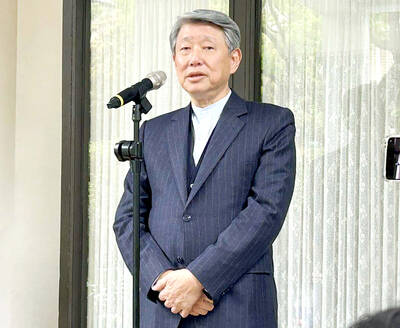ENERGY
Power use rises 4.5 percent
As domestic companies expanded production to meet global demand and people gradually changed their lifestyles amid the COVID-19 pandemic, Taiwan’s energy consumption increased 4.5 percent last year from 2020, the Ministry of Economic Affairs said yesterday. Energy consumption in the industrial sector increased 8.5 percent from a year earlier due to increased economic activities; it decreased 5.2 percent in the transportation sector as people avoided going out to comply with social distancing measures; it rose 2.6 percent in the residential sector as people spent more time at home; and it fell 1.4 percent in the service sector due to the government’s COVID-19 restrictions, the ministry said in a statement.
TELECOMS
Taiwan Mobile optimistic
Telecom operator Taiwan Mobile Co (台灣大哥大) yesterday told investors that revenue this year would expand 15 to 17 percent from NT$15.61 billion (US$559.9 million) last year, mainly driven by its e-commerce subsidiary Momo.com Inc (富邦媒體). Taiwan Mobile said its mobile service revenue is projected to rise 3 to 5 percent year-on-year, after returning to growth last year, as 5G subscribers propped up the average revenue per user, helping to drive up revenue 4 percent annually. This year, Taiwan Mobile has set aside NT$11.2 billion for capital spending, with NT$6.43 billion to go toward its telecom business, it said. However, it would reduce spending on 5G-related buildup this year after it reached its peak last year, the company said. The company’s projection does not factor in its proposal to merge with local peer Taiwan Star Telecom Corp (台灣之星).
ELECTRONICS
Luxshare plans share sale
Apple Inc supplier Luxshare Precision Industry Co (立訊精密) is seeking to raise up to 13.5 billion yuan (US$2.13 billion) through a private share placement to fund a series of projects from intelligent wearable device manufacturing upgrades to electric vehicle component production. The Shenzhen, China-listed company plans to issue up to 2.1 billion shares to as many as 35 investors, including mutual funds, securities firms, trusts, finance companies, insurers and select foreign institutional investors, it said in an exchange filing. The firm aims to spend 6.2 billion yuan of the proceeds to construct or upgrade facilities and technology related to the production of intelligent wearable devices, and about 2 billion yuan on the production of electric vehicle components, the statement said. About 3.55 billion yuan of the proceeds would be used to supplement working capital, it added.
TRANSPORTATION
NDC approves light-rail plan
The National Development Council (NDC) has approved a feasibility study for the construction of a light-rail line linking Wugu (五股), Lujhou (蘆州) and Taishan (泰山) districts in New Taipei City, the city’s Department of Rapid Transit Systems (DORTS) said on Monday. The study would need to be approved by the Cabinet before New Taipei City can proceed with the next steps, which include an environmental impact assessment that would take three years, DORTS said. If construction on the 11.61km line goes ahead, it is estimated to cost NT$22.78 billion and could take about six years to complete, the department said. Construction of the project could be completed by 2030, the New Taipei City government has said, adding that it is designed to alleviate the traffic congestion that plagues the areas during rush hour.

MULTIFACETED: A task force has analyzed possible scenarios and created responses to assist domestic industries in dealing with US tariffs, the economics minister said The Executive Yuan is tomorrow to announce countermeasures to US President Donald Trump’s planned reciprocal tariffs, although the details of the plan would not be made public until Monday next week, Minister of Economic Affairs J.W. Kuo (郭智輝) said yesterday. The Cabinet established an economic and trade task force in November last year to deal with US trade and tariff related issues, Kuo told reporters outside the legislature in Taipei. The task force has been analyzing and evaluating all kinds of scenarios to identify suitable responses and determine how best to assist domestic industries in managing the effects of Trump’s tariffs, he

TIGHT-LIPPED: UMC said it had no merger plans at the moment, after Nikkei Asia reported that the firm and GlobalFoundries were considering restarting merger talks United Microelectronics Corp (UMC, 聯電), the world’s No. 4 contract chipmaker, yesterday launched a new US$5 billion 12-inch chip factory in Singapore as part of its latest effort to diversify its manufacturing footprint amid growing geopolitical risks. The new factory, adjacent to UMC’s existing Singapore fab in the Pasir Res Wafer Fab Park, is scheduled to enter volume production next year, utilizing mature 22-nanometer and 28-nanometer process technologies, UMC said in a statement. The company plans to invest US$5 billion during the first phase of the new fab, which would have an installed capacity of 30,000 12-inch wafers per month, it said. The

Taiwan’s official purchasing managers’ index (PMI) last month rose 0.2 percentage points to 54.2, in a second consecutive month of expansion, thanks to front-loading demand intended to avoid potential US tariff hikes, the Chung-Hua Institution for Economic Research (CIER, 中華經濟研究院) said yesterday. While short-term demand appeared robust, uncertainties rose due to US President Donald Trump’s unpredictable trade policy, CIER president Lien Hsien-ming (連賢明) told a news conference in Taipei. Taiwan’s economy this year would be characterized by high-level fluctuations and the volatility would be wilder than most expect, Lien said Demand for electronics, particularly semiconductors, continues to benefit from US technology giants’ effort

‘SWASTICAR’: Tesla CEO Elon Musk’s close association with Donald Trump has prompted opponents to brand him a ‘Nazi’ and resulted in a dramatic drop in sales Demonstrators descended on Tesla Inc dealerships across the US, and in Europe and Canada on Saturday to protest company chief Elon Musk, who has amassed extraordinary power as a top adviser to US President Donald Trump. Waving signs with messages such as “Musk is stealing our money” and “Reclaim our country,” the protests largely took place peacefully following fiery episodes of vandalism on Tesla vehicles, dealerships and other facilities in recent weeks that US officials have denounced as terrorism. Hundreds rallied on Saturday outside the Tesla dealership in Manhattan. Some blasted Musk, the world’s richest man, while others demanded the shuttering of his